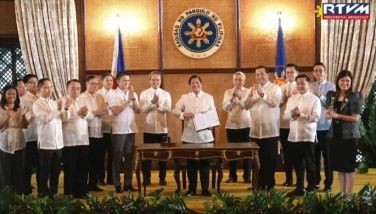More government agencies, LGUs allowing e-payments
MANILA, Philippines — More agencies and local government units (LGUs) are now allowing individuals and businesses to pay taxes, permits and other obligations to the government digitally, according to the Bangko Sentral ng Pilipinas (BSP).
In a virtual press briefing, BSP Governor Benjamin Diokno said more agencies are now participating in the government electronic-payment (EGov Pay) facility that was launched last November.
“Aside from providing convenience in receiving and making payments, digital payment initiatives pursued by the BSP will further enhance the country’s overall competitiveness as we begin to transition to the new economy,” Diokno said.
The BSP chief said around 180 government entities are expected to be onboard the facility by the end of this year. Participating agencies right now include the Bureau of Internal Revenue (BIR), Department of Trade and Industry (DTI), Philippine National Police (PNP), Overseas Workers Welfare Administration (OWWA) and various local government units.
Vicente de Villa III, managing director of the BSP’s Financial Technology Sub-Sector, told reporters around 65 government agencies are now using the electronic portal of state-run Land Bank of the Philippines, from only two when EGov was launched last November.
Likewise, Diok-no added a total of 21 more BSP-supervised financial institutions are set to join the existing seven participants now offering payments via the national quick response code standard or QR Ph.
The BSP chief said the adoption of QR Ph would accelerate digital payments with the efficiency of scanning a standard QR code instead of encoding a payee’s account details.
According to the central bank, person-to-merchant (P2M) transactions via QR Ph within the fourth quarter complementing the person-to-person (P2P) transactions launched last November.
“This will enable merchants, including micro and small vendors, to accept e-payments by merely displaying a standard QR Code for their customers to scan,” Diokno said.
The use of QR codes for payments has been gaining traction as an alternative to the traditional debit and credit card payments. The QR technology has emerged as the most expedient means of payment since it essentially entails code scanning which is faster and easier to do than bringing out a card, tapping, dipping or swiping it, and signing a charge slip in most cases.
Likewise, consumers benefit having faster, easier and cheaper payment options with greater convenience.
Both EGov Pay and QR Ph uses fund transfers via PESONet and InstaPay, the automated clearing houses under the National Retail Payment System (NRPS) launched in December 2015.
Diokno reported nearly two million of the Social Security System’s Small Business Wage Subsidy (SBWS) fund were disbursed through PESONet as of May 20.
The first tranche of SBWS covers 3.4 million eligible employees of small business affected by the enhanced community quarantine. It is expected that about 2.2 million beneficiaries with bank and e-money accounts will receive the SBWS through the PESONet.
Likewise, Landbank is expected to convert nearly 3.9 million Pantawid Pamilyang Pilipino Program (4Ps) accounts into interoperable transaction accounts starting August.
Currently, deposits into the 4Ps accounts with the LandBank are limited to social aid from the Department of Social Welfare and Development (DSWD).
“These digital payment initiatives enhance coordinated government action and uplift the wellbeing of the Filipinos amid the challenges brought about by the COVID-19 pandemic. Moving forward, we shall continue to build pathways toward a cash-lite Philippine economy,” the BSP chief said.
Diokno reiterated the central bank is committed to achieve at least 50 percent of retail payment transactions shifted to digital and 70 percent of adult Filipinos having and using a transaction account.
- Latest
- Trending


























 Exclusive
Exclusive


